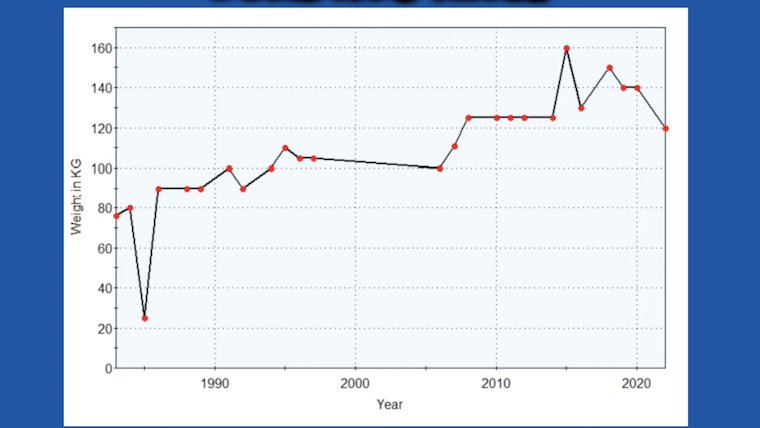Laurence Shahlaei and Liz Mason’s Stats Show World’s Strongest Man Events Have Gotten Heavier
Following the KNAACK Giant’s Live Medley at the 2022 World’s Strongest Man (WSM) Final on May 28, 2022, four-time WSM champion Brian Shaw was interviewed following his sixth-place run of 30.78 seconds.
During that interview, Shaw stated that he feels the weights used in competition are too light. He said it is a claim he has made multiple times, though he did not state if he was referring only to medleys and loading events or to WSM events as a whole.
On June 3, 2022, former strongman Laurence Shahlaei and his wife Liz Mason took to their YouTube channel to break down the stats of seven WSM events since 1983 to determine if the weights have gotten lighter. Shahlaei mentions how strongman fans take to social media to proclaim how weights have gotten lighter share their concern if the contest’s name lives up to the title it awards.
The short answer is the weights have not gotten lighter. In fact, the weights have, for the most part, only increased since the inaugural WSM contest in 1977, barring some adjustments for when weights were too heavy for athletes. Check out the full video below:
Disclaimer: the stats used in this article were sourced by Laurence Shahlaei and Liz Mason.
[Related: The 10 Most Memorable Moments From the 2022 World’s Strongest Man]
Shahlaei and Mason cover seven events that have been part of WSM for most of its existence and are still often used in modern contests: Super Yoke, Farmer’s Walk, Log Lift for reps, Deadlift for reps, Squat for reps, Loading events, and Stone loading (e.g, Atlas Stones). The graphs used in the breakdowns below take into account the max weight used in each event.
Farmer’s Walk
It’s apparent how much Farmer’s Walk has increased in weight over the past four decades. Notably, since 2010, the Farmer’s Walk has only been used as part of a medley rather than a standalone event, but has still maintained a steady track of 150 kilograms (330.7 pounds) in recent years.

[Related: Larry Wheels Hitches a 930-Pound Deadlift Triple in Training]
The implements used for the Farmer’s Carry are much larger and arguably clunkier now than in the earlier years of WSM. The event first debuted at the 1983 WSM contest and used very short logs rather than the long beams or frames often seen today.
Loading Events
Loading Races are difficult to directly compare because of the varying shapes of the implements year to year. For example, in 2020, athletes loaded monster truck parts, while in 2022, they loaded anvils, sandbags, and stones.
It is not unusual for Loading Races to include other awkward implements such as kegs, tires, or other misshapen objects.
The data in the graph below is derived from Loading Races that used a minimum of three implements. Additional factors that vary between Loading Races year over year are the distance, terrain, and height of the platforms — the latter of which has gotten higher in most recent WSM contests.

[Related: Interview: 2022 WSM Winner Tom Stoltman Talks Atlas Stone Nerves & Trusting His Coach]
Aside from the outlier of 25-kilogram implements at the 1985 WSM contest, the implements have gotten heavier, maxing out at 160 kilograms (352.7 pounds) at the 2015 WSM. The dip in weight from 2020 to 2022 is likely due, in part, to the athletes having to load an additional implement — they loaded five objects over a 20-meter course in 2022.
Stones
The Atlas Stones may be the marquee event of the WSM competition nowadays, but they weren’t introduced until nine years into the contest’s tenure in 1986. As seen in the graph below, the Atlas Stones have primarily only gotten heavier over time. The numbers below are referring to the heaviest stone used each year.

[Related: 2022 World’s Strongest Man Atlas Stones Results — Tom Stoltman Triumphant]
The 10-kilogram dip from the 2021 WSM to the 2022 WSM is potentially a trade-off for the additional walks of descending lengths with the stones (i.e., the lightest stone has the farthest walk to the pedestal and the heaviest stone has no walk to the pedestal) rather than all the stones needing only to be lifted to their respective pedestals.
Additionally, earlier WSM contests did not feature the pedestals used today on which the stones must be loaded and secured.
Log Lift for Reps
While the Log Lift has been a mainstay for the majority of WSM’s existence, the Log Lift for reps event debuted in 1993. In its first few appearances, athletes were braced against a wall, requiring the implements to be lighter.

[Related: 2022 World’s Strongest Man Day Five Results — Tom Stoltman Reigns Atop the Power Stairs]
While there has been a dip of 20 kilograms in the weight of the logs used since 2017, the trajectory of the weight used over the event’s history is a steep hill.
Super Yoke
The Super Yoke first appeared in WSM competition in 1995, where implements appeared to dangle from the frame athletes carried across their shoulders, influencing the stability of their midline. The first two instances of the event were at 300 kilograms and then sharply increased to 400 kilograms in 1998.
That proved too much of an increase in too short a time and it was brought back down a bit. It steadily increased to its peak of 600 kilograms (1,322.8 pounds) in 2019.

[Related: Live from World’s Strongest Man (with Phil Blechman)]
Shahlaei expressed how heavy the yoke was in 2019 when he competed, as he struggled with such a massive load. The weight was brought back down from that peak but remains on the heavier side of history at 450 kilograms (992.1 pounds). Notably, for the last several years the Super Yoke has been part of a medley rather than a standalone event.
Shahlaei believes that around 1,000 pounds is a solid baseline for when the yoke is used in medley events and 500 kilograms (1,102.3 pounds) is reasonable for standalone events.
Deadlift for Reps
The Deadlift for reps event debuted in 1997 at 300 kilograms. While the weight bounced around over the years since, the trajectory, like all the other events, is largely upward. Similar to other events, what the athletes must physically deadlift each year varies.
Implements include cars, metal baskets filled with kegs, and frames loaded with wheels of cheese, and the barbells vary as well (e.g., standard, axle).

[Related: 2022 World’s Strongest Man Deadlift Results — Novikov Nose Bleeds To 15 Reps]
The peak weight for this event was in 2018. The stark variations in weight are also influenced by when a Deadlift for reps is used as a standalone event, or as part of a medley or race.
Squats for Reps
Since the Squat for Reps event entered the WSM event lineup in 2000, it has had a flatter trajectory than many of the other events. While the weights have only ever increased from the 318.5 kilograms (702.2 pounds) it debuted with, the 2022 WSM contest saw that same weight that was used in 2000.

[Related: 2022 World’s Strongest Man Reign Total Body Fuel Power Stairs Results — Boudreault Steps Up]
The Squat for Reps event is similar to its counterparts in that the implements vary year to year. Squats have been loaded with people, kegs, and circus bells (spheres), among other odd objects. As such, the range of motion required for a clean rep has not necessarily been consistent year to year.
View this post on Instagram
A post shared by SBD World’s Strongest Man (@theworldsstrongestman)
[Related: 2022 World’s Strongest Man Deadlift Ladder Results]
Strongman Is Heavy
The weights used at the WSM contest do experience periodic fluctuations. That said, factors such as the distance those weights are carried, the awkwardness of the shape of those implements, the terrain those implements are carried across, and the environment in which the events are performed need to be taken into account.
The notion that WSM events aren’t as heavy as they used to be, or that event weights are getting lighter, is an idea not based in reality and not supported by credible data.
Some adjustments to the 2023 WSM may be made following the outpouring of feedback from the 2022 competition. Perhaps the height of the Atlas Stone pedestals will change, or the climate on the days of the competition won’t be as hot.
There are a plethora of confounding variables that influence how a given event plays out. Regardless, that ever-changing field of play has always been par for the course in the biggest competition in strongman. The athletes, as always, must expect the unexpected.
Featured image: @theworldsstrongestman on Instagram
Deja una respuesta

►Te puede interesar...